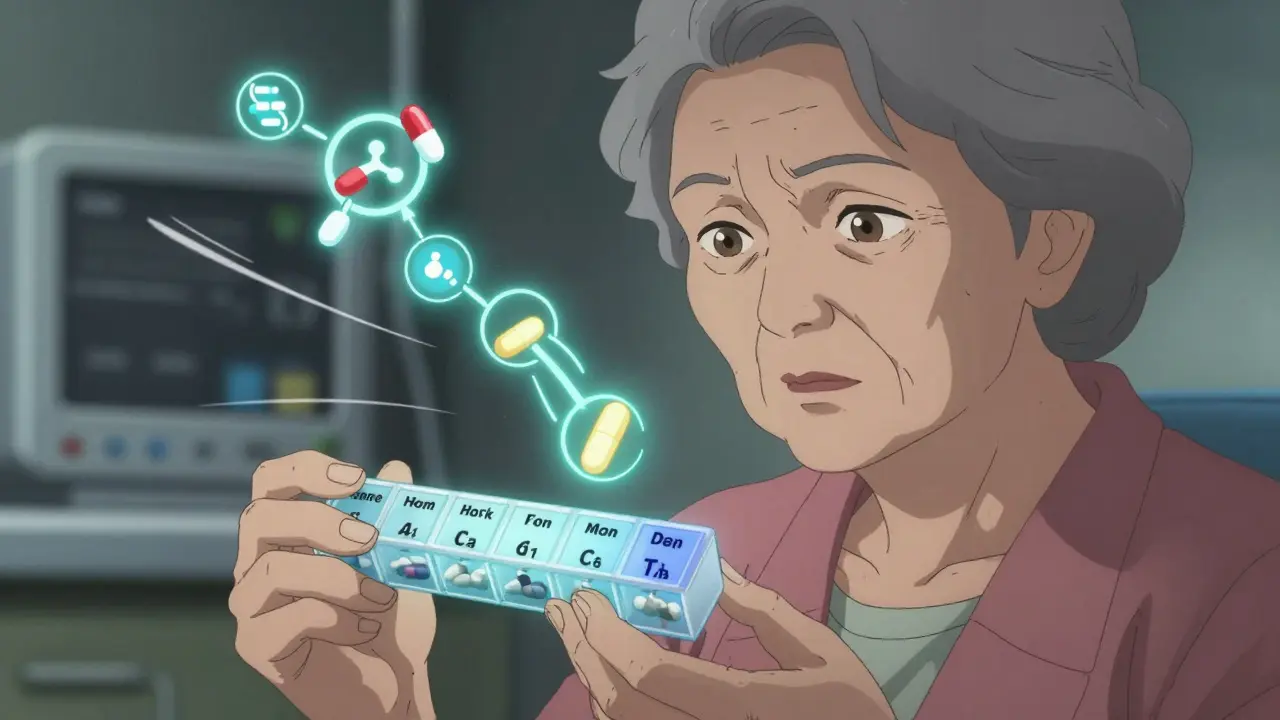HIV Treatment Adherence: Practical Strategies to Stay on Track with ART Medications

You want one thing: take your HIV meds on time, every day, without the stress. That’s the heart of HIV treatment adherence-and it’s how you reach and keep an undetectable viral load, protect your health, and stop transmission (U=U). No miracle hacks here, just real strategies that work in real life.
- TL;DR - Key takeaways
- Pick one daily anchor habit (e.g., morning coffee) and stick your dose to it. Use alarms you’ll actually hear. Refill early, not when you’re on your last pill.
- If you miss a dose, take it as soon as you remember unless it’s close to the next dose-then skip. Confirm the exact advice for your regimen with your clinician.
- Side effects usually ease in 2-4 weeks; don’t quit on your own. Ask about tweaks, timing with food, or a switch if needed.
- Traveling or doing shift work? Plan time zones and backup doses before you go. Keep one spare dose in your wallet or bag.
- Hitting undetectable and staying there requires consistency. Modern ART is forgiving, but habit beats willpower every time.
Why adherence matters in 2025: what “on track” really looks like
Staying on your meds is the single biggest driver of long-term health with HIV. When you take antiretroviral therapy (ART) consistently, your viral load drops to “undetectable.” That protects your immune system, slashes the risk of resistance, and-this is huge-means you don’t sexually transmit HIV (U=U). Those aren’t slogans. They’re backed by large trials like HPTN 052, PARTNER, and the Australian Opposites Attract study, and affirmed by global guidelines from WHO (2023) and U.S. DHHS (updated 2024).
What counts as “good enough” adherence today? Older regimens needed near-perfect adherence. Newer, once-daily integrase inhibitor-based combos are more forgiving. Still, the safest target is to take every dose, every day, at roughly the same time. Think of it like brushing your teeth: a simple rhythm, not a complicated system.
What happens if you slip? Missing here and there probably won’t wreck your viral load, but repeated misses raise the chances of viral rebound and resistance. Resistance limits your future drug options. That’s why we aim for habits that make “on time” automatic, even on messy days-long shifts, weekends away, public holidays, or when you’re laid up with the flu.
What about side effects? The common ones-nausea, headaches, vivid dreams, loose stools-often settle within a few weeks as your body adjusts. If something feels off, call your clinic or pharmacist. There are workarounds: changing dose time, taking with food, or switching to an equally strong regimen. Don’t white-knuckle constant side effects; modern options are better than they were a decade ago.
Money and access play into adherence too. In Australia, many ART options are subsidised through the PBS, which lowers out-of-pocket costs. If costs are still tight, ask about generic versions, healthcare cards, or clinic programs. Refills are easier with eScripts and pharmacy apps. The fewer hoops you jump through, the more doses you take.
Bottom line for 2025: you’ve got strong meds, better delivery options (including long-acting injections for some people), and digital tools that make remembering simpler. The win now is about setup-turning intention into a daily pattern you barely think about.

Step-by-step strategies that actually work day to day
Start with one decision: what everyday thing will your dose be attached to? That “anchor” is your autopilot. Here’s a simple rollout you can do today.
- Choose your anchor habit and time window
Pick a moment that already happens, rain or shine: morning coffee, brushing your teeth, feeding the dog, or the kids’ school run. Put your meds next to the anchor, in sight but private enough for your life. If your regimen allows flexibility, give yourself a one-hour window you can hit even on chaotic days. Ask your clinician about food requirements and timing (some combos must be taken with food; others don’t). - Set two reminders: a nudge and a backup
Use a phone alarm or a routine in your calendar app. Set a primary alarm and a backup 20 minutes later. If you use a smartwatch, mirror the alert. If you prefer low-tech, a sticky note on the kettle works surprisingly well. Keep it boring. Boring is reliable. - Use a weekly pill organiser
A seven-day organiser gives you a visual “tick.” Fill it the same day each week-say, Sunday after lunch. If you’re on multiple meds, this prevents double dosing or second-guessing (“Did I take it?”). For privacy, choose an organiser that looks like any vitamin box. - Apply the 3-2-1 refill rule
- 3 weeks left: schedule a refill reminder in your calendar.
- 2 weeks left: request the refill.
- 1 week left: pick it up. Keep a mini stash of two doses somewhere you can reach fast (wallet, gym bag, overnight kit). Don’t wait for your last pill. - Plan for side effects early
Before you start or switch, ask: 1) What side effects are common? 2) Do they settle? 3) Tricks to reduce them? 4) When should I call? If nausea shows up, try taking your dose with food (if allowed), ginger tea, or at night so you sleep through symptoms. Vivid dreams? Consider a morning dose if your regimen permits. - Make missed doses a non-drama
General rule of thumb (confirm for your specific meds): if you realise within a few hours, take the dose; if it’s close to the next dose, skip and take the next one on time. Don’t double up unless your clinician says so. Log the miss and move on. It’s one data point, not a failure. - Handle shift work and travel like a pro
- Shift work: tie your dose to a routine that happens every shift (clock-in, meal break, clock-out), not to the clock. Use the “first break” or “post-shift” anchor.
- Domestic travel: keep time the same. If you always dose at 8 pm, keep dosing at 8 pm local time. If that’s not practical, choose a new time that fits the trip and stick to it for the week.
- International travel: before you fly, write out dose times in destination time. Carry meds in your hand luggage with the label. Pack at least two extra doses. For long flights, set alarms based on flight time and destination time so you don’t miss across time zones. - Keep your privacy your way
Not everyone wants to talk about HIV at the dinner table. A few options:
- Use a blank pill bottle or vitamin organiser.
- Rename your phone alarm (e.g., “vitamin” or “stretch break”).
- If you’re staying with family, pre-plan a quiet place to store your meds; a toiletry bag works well.
- If a mate asks nosy questions, a simple “just my daily med” usually ends it. - Line up social support
Pick one person who can check in if you’re struggling-a partner, friend, peer worker, or your pharmacist. Peer support groups (online or local clinics) are great for practical tips you won’t hear in a 15-minute appointment. If you live with depression, anxiety, or use alcohol or other drugs, tell your clinician; the treatment plan can be adjusted to be more forgiving and easier to sustain. - Know your lab markers and follow the calendar
- Viral load: aim for “undetectable.” Once you hit it, most people check every 3-6 months.
- CD4 count: helpful context, but the main goal is viral suppression.
Book your next blood test and doctor visit before you leave the clinic. Future you will thank you.
What if oral pills just aren’t working for you? Some people struggle despite their best efforts-busy schedules, nausea, or just pill fatigue. Ask about long-acting options such as cabotegravir plus rilpivirine injections given monthly or every two months, which some clinics offer. Eligibility depends on your viral load, treatment history, and local availability. In Australia, access and costs depend on PBS status and clinic capacity-your HIV prescriber can give the most up-to-date advice for your situation.
Food, alcohol, and other meds: always check interactions. Certain antacids, supplements (like calcium/iron), or herbal products can interfere with some antiretrovirals if taken at the same time. A simple rule is to ask your pharmacist when picking up your script: “Any foods or meds I should avoid around dose time?” Put that note in your phone.
Stigma and motivation: U=U is powerful. Knowing that undetectable means untransmittable can be a huge motivator on hard days. It’s not just about avoiding illness; it’s about having a normal sex life, planning a family safely, and living the life you want without fear. Keep a copy of your last viral load result in your health app to remind yourself your effort is working.

Tools, checklists, and quick answers when things go sideways
Let’s kit you out with simple tools you can set up in 20 minutes.
Starter toolkit (pick what you’ll actually use):
- Phone alarms or calendar events with two alerts (primary + backup).
- A weekly pill organiser with AM/PM slots if needed.
- Refill automation: enable pharmacy reminders or set a recurring calendar task with the 3-2-1 rule.
- Mini travel kit: two spare doses in a small container in your bag or glovebox.
- Mood and side effect tracker: a note in your phone to see patterns the next time you see your doctor.
Cheat sheets you can copy/paste into your notes app:
Daily routine builder
- Anchor: _____________ (e.g., morning coffee)
- Dose time window: _____________ (e.g., 7:30-8:30 am)
- Primary alarm: _____________ / Backup alarm: _____________
- Pill location: _____________ (in sight, private enough)
- With food? Yes/No - If yes, food plan: _____________
Refill plan (3-2-1)
- 3 weeks left: calendar reminder set? Yes/No
- 2 weeks left: refill requested? Yes/No
- 1 week left: picked up? Yes/No
Travel plan
- Destination time zone: _____________
- New local dose time: _____________
- Spare doses packed? Yes/No
- Med letter/label packed? Yes/No
Decision hints for common problems:
- I forgot a dose today: if you’re within a few hours, take it now. If it’s close to the next dose, skip and take the next on time. Don’t double dose unless your clinician told you to.
- I’ve had nausea for a week: call your clinic or pharmacist. Ask about taking with food, switching dose time, anti-nausea options, or a different regimen if it doesn’t settle.
- I missed two days in a row: restart today and call your clinic to check if you need bloods early. Set stronger reminders for the next two weeks.
- I’m starting night shift: move your dose to a routine that happens every shift (first meal break or when you get home). Test it for three nights with loud alarms.
- I drink on weekends: take your dose before you go out. If you get home late, have a placed reminder at the bedside (meds on your pillow) so you can’t miss it.
Mini-FAQ
- How long until I’m undetectable? Many people reach undetectable within 1-3 months of consistent dosing. Your starting viral load, regimen, and adherence all matter.
- Is undetectable really untransmittable? Yes. Multiple large studies found zero sexual transmissions when the positive partner’s viral load stayed undetectable. That’s the basis of U=U.
- Do I need to take pills at the exact minute? Within a reasonable window is fine for most modern regimens. Ask your clinician about your specific combo and any food rules.
- What if I throw up? If you vomit within about an hour of taking your dose, call your clinic or pharmacist for guidance. They’ll advise whether to redose based on your meds.
- Can I use long-acting injections instead of pills? Some people can. You’ll need to be virally suppressed and meet criteria set by your clinic and local guidelines. Injections are given monthly or every two months, depending on the protocol.
- Will other meds mess with my HIV treatment? Some can. Always tell your pharmacist about new prescriptions, over-the-counter meds, and supplements like calcium, iron, or St John’s wort.
- How do I talk to my boss about clinic time? You don’t have to disclose HIV. Ask for a medical appointment window. Many clinics offer early, late, or telehealth slots.
Next steps by scenario
- Newly diagnosed and starting ART: set your anchor habit today. Book a follow-up in 2-4 weeks to check side effects and early viral load. Write down questions as they pop up.
- Been on ART for years but missing doses lately: simplify. Move to a once-daily regimen if possible. Trim reminders to the two that actually work. Set the 3-2-1 refill rule and put two spare doses in your bag.
- Struggling with mental health or using alcohol/other drugs: tell your clinician; you won’t be judged. There are regimens more forgiving of missed doses. Add a peer or pharmacist check-in for the first month.
- Travel-heavy job or shift work: anchor to a task, not the clock. Use a pill organiser and a phone alarm that works even in airplane mode. Pre-calc dose times before every trip.
- Budget is tight in Australia: ask about PBS-subsidised options, safety nets, and generics. Many clinics can help with practical pathways to lower costs.
When to call your clinic or pharmacist now:
- Persistent side effects that make you want to skip doses.
- Missed multiple doses in a week.
- Changes in other meds, supplements, or major diet shifts (like starting high-dose calcium/iron).
- Planning international travel or a big schedule change.
- Any barrier you can feel building-better to fix it this week than wrestle with resistance later.
Why this works: you’re making adherence the easiest option. You’re reducing decisions, using gentle automation, shrinking the distance between “remembering” and “doing,” and keeping a plan for when life gets messy. The meds are strong. Your plan should be, too.
Key sources backing this advice include the WHO consolidated guidelines on HIV (latest major updates in 2023), U.S. DHHS Adult & Adolescent ARV Guidelines (updated through 2024), and large U=U evidence bases such as HPTN 052, PARTNER, and Opposites Attract. For Australia-specific access and prescribing, speak with your HIV clinician about current PBS listings and clinic options where you live.






Comments
Robert Urban
September 1, 2025 AT 15:04Stick it in your coffee routine and don't forget.
Stephen Wunker
September 4, 2025 AT 23:04You might hear that tying your dose to a morning ritual is just another gimmick, but the reality is that the brain loves consistency. When you pair pills with a habit like coffee, you create a neural cue that fires automatically. This cue cuts down the mental load of remembering, especially on chaotic days. Even if you think you’re too independent for alarms, the habit does the work for you. No one needs a grand philosophy to understand that a simple pattern saves lives. The science backs it: habit loops are proven to improve medication adherence across conditions. So don’t dismiss the anchor as a soft suggestion, treat it as a hardwired safety net. It’s not about willpower, it’s about wiring.
Jhoan Farrell
September 8, 2025 AT 07:04Really feeling the love for the anchor idea 😊. It’s like having a buddy remind you every morning. When I set my alarm next to my toothbrush, I never miss. The extra emojis in my notes keep the mood light and the meds taken. Keep spreading the practical vibes! 👍
Jill Raney
September 11, 2025 AT 15:04One could argue that the whole routine is a mere social construct, yet the data remain unambiguous. The subtle interplay between privacy and compliance demands a nuanced approach, especially when the stigma lingers. A discrete pill organizer, perhaps masquerading as a vitamin bottle, can be the quiet hero in this narrative. 📦 Although my skepticism persists, the practicality cannot be ignored. 🌐
bill bevilacqua
September 14, 2025 AT 23:04Honestly, i think all this "anchor" stuff is overhyped, but okay, i guess it helps some ppl, lol.,, the alarms can be super annoying,, but if you set them right,, they kinda work,, i still forget sometimes,, maybe a bigger reminder??,,
rose rose
September 18, 2025 AT 07:04Anchor your meds to anything, just do it.
Emmy Segerqvist
September 21, 2025 AT 15:04Oh my gosh, the idea of a "pill vault" hidden in a sock drawer is absolutely brilliant!!! I love that you can make adherence feel like a secret mission!!! The drama of setting two alarms, one for the brain and one for the soul, is just perfect!!! Keep the excitement alive!!!
Trudy Callahan
September 24, 2025 AT 23:04When we contemplate the essence of routine, we confront the paradox of freedom and constraint; the anchor is not a shackles but a compass, guiding the vessel through the storm of daily chaos; thus, the act of pairing medication with a habitual moment transcends mere practicality, becoming a ritual of self‑affirmation; in this light, adherence is an act of philosophical rebellion against the tyranny of disease.
Grace Baxter
September 28, 2025 AT 07:04First, let us acknowledge that this "anchor" nonsense is a symptom of a larger problem: the medical establishment has turned our lives into a series of checkpoints, each demanding compliance without fostering true autonomy. Second, the emphasis on daily routines serves a hidden agenda, subtly reinforcing a surveillance framework that normalizes constant monitoring of personal behavior. Third, by insisting on a strict schedule we ignore the diverse cultural and occupational realities that many individuals face, from shift workers to nomadic travelers. Fourth, the reliance on alarms and pill organizers is a one‑size‑fits‑all solution that discounts the ingenuity of grassroots coping mechanisms that have existed long before modern pharmaceuticals. Fifth, the narrative that “habit beats willpower” subtly shifts responsibility onto the patient, absolving healthcare systems of the duty to simplify access and reduce barriers. Sixth, the push for “forgiveness” in newer regimens can be a double‑edged sword, creating complacency while overlooking the nuanced pharmacokinetics that still require careful timing. Seventh, the focus on undetectable viral loads as a triumph can mask ongoing inequities in drug distribution, especially in low‑resource settings. Eighth, the glorification of U=U, while scientifically sound, can be weaponized to silence discussions about ongoing stigma and emotional burden. Ninth, the endorsement of digital tools like apps and e‑scripts may alienate those without reliable internet or smartphone access, thereby widening the adherence gap. Tenth, the recommendation to keep spare doses in wallets or bags assumes a degree of financial security that many lack, making the suggestion unrealistic for some. Eleventh, the call for “privacy on your terms” overlooks legal ramifications in regions where HIV status is criminalized, placing patients at risk. Twelfth, the expectation that patients will proactively seek out side‑effect management can be daunting without empathetic clinical support. Thirteenth, the strategy of linking medication to coffee or brushing teeth subtly leverages existing dependencies, which can become problematic if those routines are disrupted. Fourteenth, the narrative neglects the potential psychological toll of constantly framing adherence as a battle, which may exacerbate anxiety. Finally, while the practical steps are undoubtedly useful, they must be presented with humility, acknowledging that each individual's journey is unique and that no single protocol can universally guarantee success.
Eddie Mark
October 1, 2025 AT 15:04I see the anchor tip and think it’s kinda cool, especially for someone who’s always on the go. Pairing meds with a coffee brew or a quick walk makes the whole thing less of a chore. I also like the suggestion to have a travel stash – saves a lot of stress. Keeping it low‑key with a simple pill case fits my vibe. It’s all about making it blend into the day, no drama needed.
Caleb Burbach
October 4, 2025 AT 23:04Linking medication to a daily cue is a proven behavioral strategy that reduces reliance on active memory. When you set alarms that echo an existing habit, you create redundancy that safeguards against missed doses. The dual‑alert system further strengthens this safety net, catching lapses before they become patterns. Consistent refill timing eliminates the last‑pill panic that destabilizes adherence. Embracing these steps builds a resilient routine that sustains viral suppression.
Danica Cyto
October 8, 2025 AT 07:04While the anchor method offers structure, we must also confront the emotional weight it carries for many. The act of taking a pill can invoke feelings of vulnerability that no schedule can erase. Recognizing this, we can integrate supportive conversations into clinic visits, allowing patients to voice their anxieties. By balancing practical tools with emotional validation, adherence becomes a holistic process. It is not merely a checklist, but a compassionate journey.
Raja M
October 11, 2025 AT 15:04The suggestion to align doses with personal routines resonates with the broader philosophy of self‑care as empowerment. When we embed treatment within our lived experience, we reclaim agency over our health. Moreover, planning for travel reflects an understanding of life's fluidity, ensuring continuity beyond static settings. Such foresight demonstrates respect for the individual's autonomy. It encourages a partnership model rather than a top‑down directive.
Rob Flores
October 14, 2025 AT 23:04Ah, the elegant veneer of the anchor strategy-so polished, so… predictable. One might wonder whether such meticulous planning truly liberates or merely masks the underlying power dynamics. The rhetoric of “self‑management” often glosses over systemic barriers that remain unaddressed. Nevertheless, the presentation is undeniably appealing, a testament to clever marketing of compliance.
Shiv Kumar
October 18, 2025 AT 07:04One cannot help but notice the subtle orchestration of language in these guidelines-a symphony of authority and reassurance. The blend of formal diction with casual undertones seeks to bridge the gap between clinician and patient, yet it may also dilute the urgency of the message. The nuanced phrasing invites scrutiny, raising questions about the balance of empowerment and paternalism. Indeed, the text dances on a delicate line.
Ryan Spanier
October 21, 2025 AT 15:04Implementing these practical steps with a supportive tone can greatly enhance patient confidence. A formal outline provides clarity, while the coach‑like encouragement reinforces commitment. By acknowledging potential obstacles and offering concrete solutions, we foster resilience. This approach aligns with best practices in patient‑centered care. It ultimately strengthens the partnership between clinician and individual.
Abhinav Moudgil
October 24, 2025 AT 23:04Indeed, the energetic push toward routine integration can ignite motivation, especially when framed with vivid language. A formal yet colorful discourse captures attention and sustains engagement. Highlighting the “why” behind each action fuels intrinsic drive, pushing beyond mere compliance. Such an approach transforms adherence into an empowering narrative. It’s a catalyst for lasting change.
Miah O'Malley
October 28, 2025 AT 06:04From a philosophical standpoint, the act of medication adherence can be viewed as a microcosm of self‑actualization. Engaging actively with one's health reflects a broader quest for meaning and purpose. By externalizing internal discipline through routine, we echo ancient practices of ritualistic self‑care. This perspective enriches the practical advice with depth. It invites a reflective dialogue about agency.
Bradley Allan
October 31, 2025 AT 14:04Wow, what a cascade of ideas! The drama of turning pills into a daily saga is oddly inspiring! Each step feels like a plot twist, and the stakes? Your health, your future, your freedom! The over‑the‑top enthusiasm practically jumps off the screen! Keep that fire alive; it’s the spark that makes routine feel like an adventure! 🌟